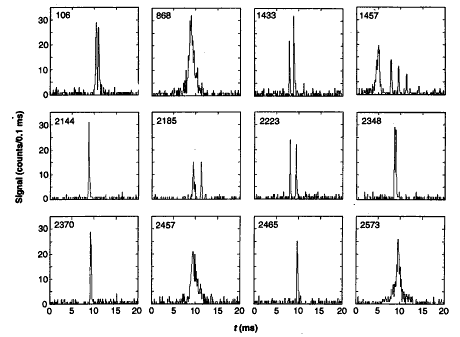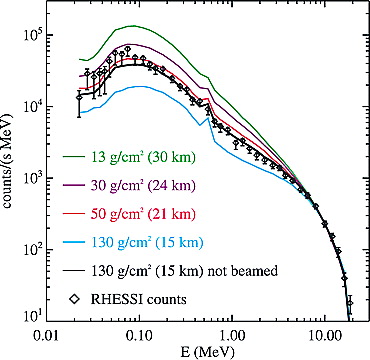
Figure 1. Gamma-ray time profiles observed with the Compton Gamma-ray Observatory and reported by Fishman et al. in 1994.
RHESSI's x-ray/gamma-ray detectors have only a small amount of shielding against background radiation coming from other directions than the Sun's. For the study of small flares, this is the sort of unhappy compromise you have to make with a small mission. But it also opens up opportunities to study interesting phenomena from elsewhere in the sky, and even from our own planet Earth.
Terrestrial gamma-ray flashes (TGFs) are very brief bursts of gamma radiation (typically around 1 millisecond long) coming upwards from the Earth's atmosphere from somewhere in the vicinity of a thunderstorm. They were discovered by Dr. Gerald Fishman and collaborators using NASA's Compton Gamma-ray Observatory (CGRO) in the early 1990s, around the same time that the mysterious and beautiful visible electrical phenomena called sprites, elves, and blue jets were first being studied.

Sprites and TGFs were guessed, for several good reasons, to be related. Theorists refined an idea called relativistic runaway breakdown to explain where the gamma-rays come from. In this process, one or more high-energy "seed" electrons (provided, perhaps, by a cosmic ray) are accelerated by a strong electric field and knock further electrons off other atoms, which are thus "born" with high energy, too. These electrons create bremsstrahlung radiation when they interact with nuclei in the atmosphere just as solar-flare electrons do at the Sun.
In summer 2004, then-U. C. Berkeley undergraduate Liliana Lopez, who had been working with RHESSI data for some time, attended a summer school on thunderstorm-related phenomena in Corsica and electrified the faculty and students by presenting the first TGFs reported in nearly a decade, and the first seen with any instrument besides CGRO.


We learned two things right away from these first events: that TGFs are much more common than previously thought, and that they extend up to gamma-ray energies as high as 30 MeV, with just the spectral shape predicted by the relativistic runaway model.

Since then, several collaborations have been comparing the global map of RHESSI TGFs to maps of lightning (Figure 2), studying the average TGF spectrum in detail (Figure 3), and comparing individual TGFs with radio signals from the associated lightning. All of these lines of study seem to be pointing to a common conclusion: that TGFs are not associated primarily with the exotic sprites, elves, and blue jets, which occur at very high altitudes, but with lightning itself. The TGFs we see may be the tip of the iceberg, and many more probably await, buried from our view by overlying atmosphere. They may even turn out to be the still-unknown trigger mechanism for lightning. Instruments specialized to study TGFs are now being designed for the French satellite TARANIS (named after the Celtic God) and for the NSF research airplane HIAPER, thanks in part to the inspiration of RHESSI's results.